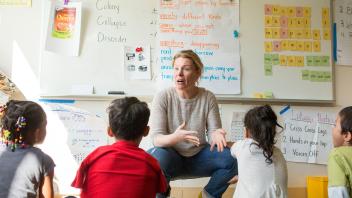Reader question: I am currently teaching workshops and courses on reading and the Common Core and have approached these with regard to disciplinary literacySpecialized texts and ways of using literacy in the disciplines.
. So many of the teachers involved are seeing the value of creating discipline-specific reading experiences in their classrooms. This is especially true of secondary teachers but upper elementary as well.
Where we are having a question is how can this apply to kindergarten classrooms. We discussed using texts that focus on science and social studies topics, how the authors might get their information, and focusing on a text structureDifferent ways of organizing the information in texts depending on their purpose.
if one is available, but beyond that teachers want to know what else they can do? Would you have any additional suggestions or resources on how these teachers can introduce DL to younger students?
Shanahan’s response:
There have been periods during American history when reading instruction has focused heavily on literature and others when we have wanted to prepare students to face real life demands. There was a period in the 19th Century when the idea was to distance schools from society as much as possible — to protect kids from the real world. And, now, we are apparently coming out of similar period. What was eventually referred to as “whole language” not only emphasized discovery over explicit teaching and participation over learning, but also literature over any other text.
Although scholars (e.g., Venezky, 1975) started criticizing this overwhelming emphasis on fiction-over-fact and story-over-exposition, it did not begin to retreat until the past decade or so. That surprises some Common Core State Standards (CCSS) fans who think that CCSS led this movement towards information, but anyone who has looked at commercial reading programs from 2000 to 2010 saw real shifts in this emphasis. Book rooms might not have changed much during that time, but core reading programs got the message that there needed to be more science and social studies in the reading curriculum.
If you spend much time with children you will find that they love stories, but they also love information (I have a 4-year-old grandson who wants anything he can find on dinosaurs and pirates). As a former first-grade teacher, I remember my kids wanting books on things like ventriloquism and ice skating — not talking bears and flying carpets.
Anyone who knows the high school curriculum is aware that kids take a literature-focused English class in ninth grade, so teaching kids to read literature will help to prepare them for that. But they also may take, Algebra, Biology, and World Culture; why not prepare them for those classes, too?
Okay, so we’re going to introduce informational textA nonfiction text whose purpose is to inform/describe/explain to the reader.
in kindergarten and throughout the primary grades. But what are we supposed to teach?
I’d argue kids should read lots of science and social studies in grades K-3, and that they should be taught to comprehend such texts. Yes, informational text can be part of the read-aloud agenda, too. My youngest daughter — the science nerd — begged me to read Jane Goodall’s In the Shadow of Man to her when she was 8.
I also think there are some very basic ideas about informational text that we’d want to teach. I’ve organized those things into 5 overarching categories that can easily be remembered with the mnemonic: Fabulous Libraries Can Give Satisfaction.
- Fact vs. Fiction: The differences between storybooks and informational texts, fact vs. fiction, value of informational texts, importance of accuracyThe ability to read words correctly.
, etc.
- Locating Information: Both how to find informational text in libraries, etc., but how to find information within such texts using tables of contents, etc.
- Comprehending/Learning from Informational Text: How informational text is organized, how to summarize info text, answering questions about information
- Use/Interpretation of Graphical Elements: How to read charts and graphs, connections of prose information and the graphics
- Synthesizing Information: Comparing information across texts, producing one’s own simple informational texts
I think you’ll find that everything that is in your educational standards concerning informational text falls comfortably into those five categories, but this perhaps gives that curriculum a greater coherence. Personally, I wouldn’t try to go much further than that in the primary grades, but compared to what we used to do, that is quite a distance. In the upper grades, those categories still work, but one has to add a lot more detail to what needs to be accomplished.

